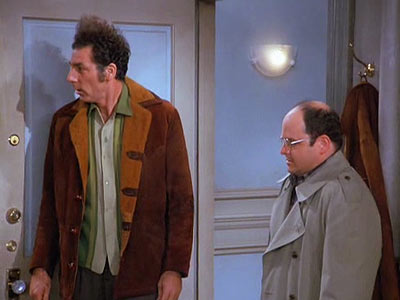Seinfeld: You Got To Have Three
Published on November 29th, 2010 in: Comedy, Issues, Three Of A Perfect Pair, TV |Analysis:
Other sitcoms would typically have one or one and a half of those story lines. A typical episode of Cheers might go like this: Diane is planning a surprise party for Sam; meanwhile, Cliff is up for Postman of the Year award. “Blair is worried when her father comes for a visit; meanwhile, Natalie and Tootie make a time capsule,” would not be out of place on The Facts Of Life.
For Seinfeld however, such a plot would seem hollow and stretched, not nearly enough material to cover 22 minutes. The principal characters are so well written, they cross over into each other’s stories.
Note how Kramer is playing proxy in two different story lines. In the second, he places the bet which is the start for the action with Jerry and Mike. Later in the third, Kramer becomes the proxy to Allison, breaking up with George in her behalf. It could have been written so that some off-screen character is the one who placed the bet, or some random friend of Allison’s confronts George, but using the already-present Kramer character makes for a comedic texture you can’t get achieve in any other way.
For example, after the scene where Kramer is talking to Jerry about Mike, George walks in, passing by Kramer. They are instantly “post-break-up” awkward with each other: “You look good.” “You. . . you too.” “Look, maybe I can call—” “No George, it’s over.”

With any other set up that entrance would be wasted time, just one person exiting, and another coming on stage to tell some jokes about another unrelated story line. With this tighter construction the comedy never has to stop and start. It’s one seamless glide from one storyline to another; the flow is never interrupted. We are always watching the next plate getting spun, the next chainsaw being juggled, the next knife thrown; we never have to wait for a new setup.
In addition to Kramer, Jerry plays multiple roles in this episode: as sounding board for Elaine and George in their respective story lines, he offers advice to them both while dealing with his own worries. When offering advice to Elaine to get rid of the Susie persona, it actually crosses over into Jerry’s own story line when Mike misinterprets it in the truck.
Even the far less significant character of Allison (this episode is her only appearance) is a plot device: it is from Allison, through George, that Kramer gets tickets to see the Knicks game. There again at that game, he actually causes a star player to be taken out of the game, allowing the Knicks (and Jerry’s bet) to win. It’s because of those tickets that Kramer goes to see Allison, starting his stand-in role for the break-up with George.
I could go on for days, ruminating on the intricate intertwining of these three story lines. It’s a structure as fragile, spare, and essential as DNA: simply complex while infinitely basic. I can see myself easily getting obsessed with it to the point of trying to carve it out of particularly thick mashed potatoes, or plastering the walls with newspaper clippings, a la John Nash in A Beautiful Mind, or even going so far as to write an article about it for a webzine.
See? Bam! You got to have three! Works every time!
Time limit is exhausted. Please reload the CAPTCHA.